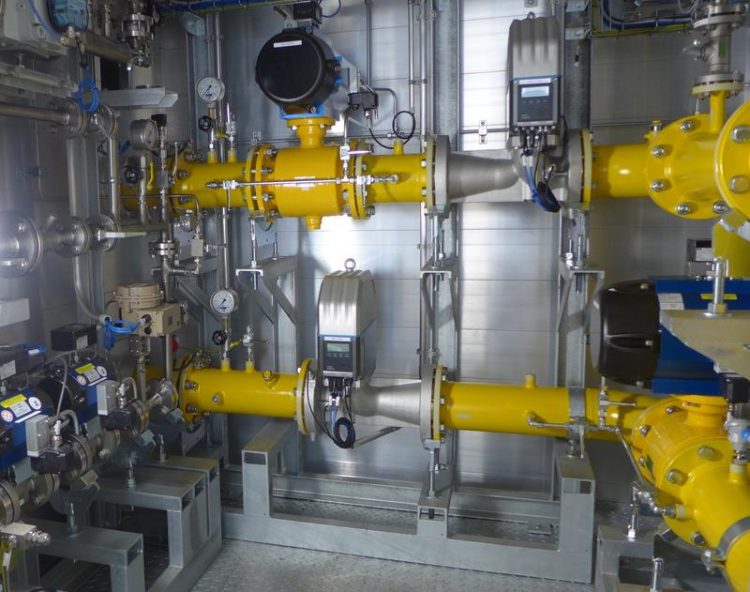Fraunhofer ISE Starts Operation of New Hydrogen Feed-In Plant

Feed-in plant mixing hydrogen into the gas mix while maintaining the characteristic/threshold values of the natural gas grid. Fraunhofer ISE
“In an energy system without fossil fuels, the fluctuations in electricity production from renewables must be balanced out,” says Dr. Christopher Hebling, Division Director of Hydrogen Technologies at the Fraunhofer Institute for Solar Energy Systems ISE. “Flexible electrolyzer systems for hydrogen production are gaining importance as one solution here. The existing natural gas grid can be used for long term storage.”
As part of its research work, Fraunhofer ISE constructed and put into operation a hydrogen generation plant for feed-in to the natural gas grid. This plant is located in the institute’s laboratory on Auerstrasse in the northern industrial district in the City of Freiburg.
The work at Fraunhofer ISE is supported by its project partners badenova / bnNETZE and the College of Applied Science Offenburg. The construction and operation in 2017 was supported with funds from the State of Baden-Württemberg through the project carrier Karlsruhe Institute of Technology KIT within the project “Kommunaler Energieverbund Freiburg” (Communal Energy Network).
Research System to Investigate Operation in the Distribution Grid
Since August 2017, the plant at Fraunhofer ISE feeds hydrogen into a natural gas supply pipeline of the communal distribution grid. Gas customers in the northern industrial district and in Gundelfingen receive gas with a mix of 2 % hydrogen.
“The targeted sector coupling makes it possible to increase the share of renewable energy in the system, and thus demonstrates an important building block of a sustainable future energy supply. As an energy and environmental service provider, we are already collecting first experiences in order to best support the ecological efforts of the region,” says Richard Tuth of the Innovation Funds and Environmental Management of badenova.
In the project “Kommunaler Energieverbund Freiburg,” complex algorithms for operating the plant were developed and tested. These algorithms for the management operation are based on a model predictive control, which means the operation is optimized daily using a simplified simulation model integrated in the algorithm.
The tested algorithms aim either for a maximum use of local green electricity or the lowest possible electricity price on the day-ahead market of the European Electricity Exchange (EEX) or rather an optimized combination of both.
These operating strategies were developed in simulations, then tested and subsequently transferred to a real plant in the practice. Even though commercialization through Fraunhofer ISE is not intended, the plant is operated based on economic and ecological aspects and validated under real operating conditions.
The plant is conceived as a research platform for optimizing the operation of the distribution grid. Even after the project ends, the plant shall continue to serve as a platform to validate different operating strategies as well as to develop and test new components for the natural gas grid.
At present, it is difficult to operate hydrogen plants with economic efficiency, since the legal regulations governing hydrogen are disadvantageous compared to other technologies. By adjusting the legal regulations to facilitate a more just market entry, however, these technologies can then dramatically contribute to the reduction of carbon emissions in the heat, mobility, industrial raw materials and gas sectors and advance the energy transformation.
Media Contact
All latest news from the category: Power and Electrical Engineering
This topic covers issues related to energy generation, conversion, transportation and consumption and how the industry is addressing the challenge of energy efficiency in general.
innovations-report provides in-depth and informative reports and articles on subjects ranging from wind energy, fuel cell technology, solar energy, geothermal energy, petroleum, gas, nuclear engineering, alternative energy and energy efficiency to fusion, hydrogen and superconductor technologies.
Newest articles

High-energy-density aqueous battery based on halogen multi-electron transfer
Traditional non-aqueous lithium-ion batteries have a high energy density, but their safety is compromised due to the flammable organic electrolytes they utilize. Aqueous batteries use water as the solvent for…

First-ever combined heart pump and pig kidney transplant
…gives new hope to patient with terminal illness. Surgeons at NYU Langone Health performed the first-ever combined mechanical heart pump and gene-edited pig kidney transplant surgery in a 54-year-old woman…

Biophysics: Testing how well biomarkers work
LMU researchers have developed a method to determine how reliably target proteins can be labeled using super-resolution fluorescence microscopy. Modern microscopy techniques make it possible to examine the inner workings…





















